Google Nexus 9: Preliminary Findings
by Joshua Ho on November 3, 2014 1:00 PM ESTGPU Performance
Following along the same lines, we can also take a look at the GPU performance of Tegra13x in the Nexus 9. This really shouldn’t change too much though as the same GPU is used at the same maximum clock speed of 852 MHz. For those that are unfamiliar with the GPU in the Tegra K1, this is effectively a scaled-down version of their desktop Kepler GPUs.

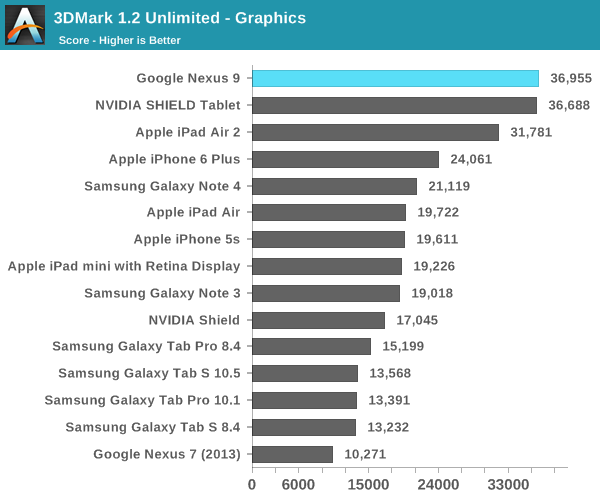
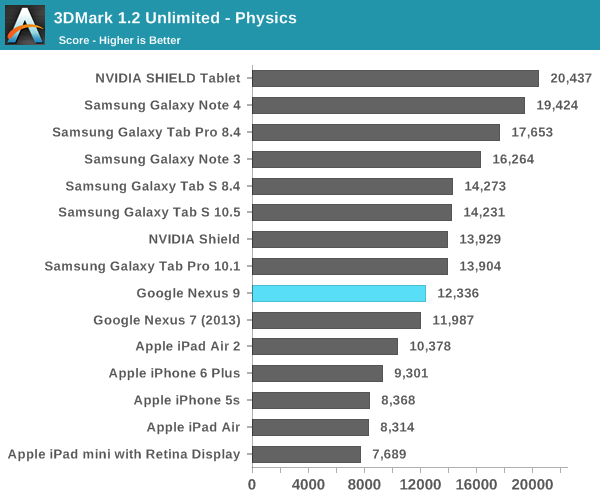
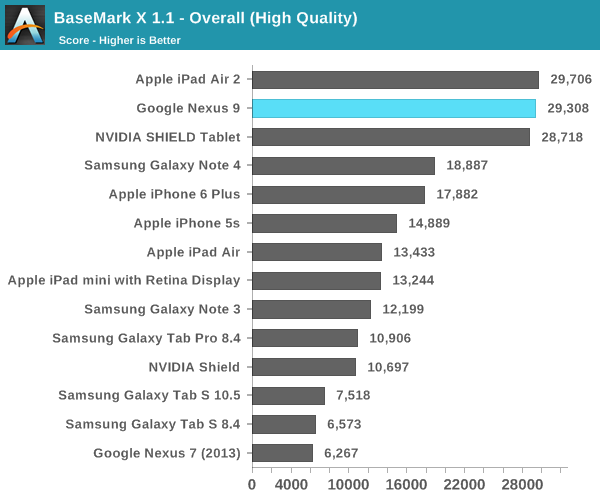
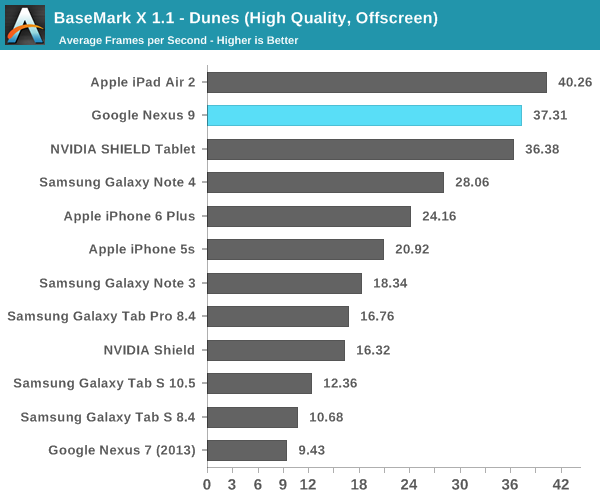
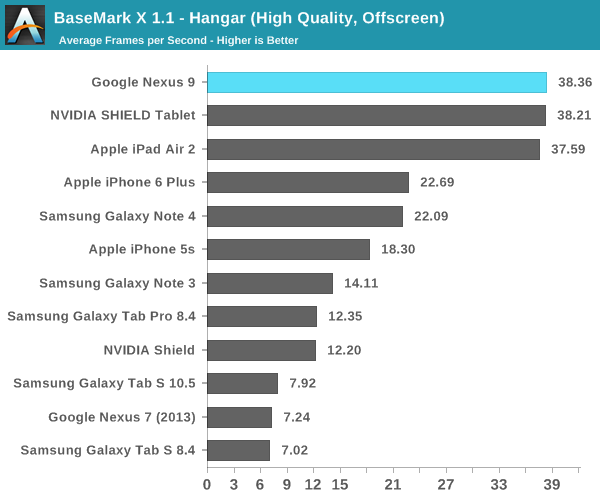
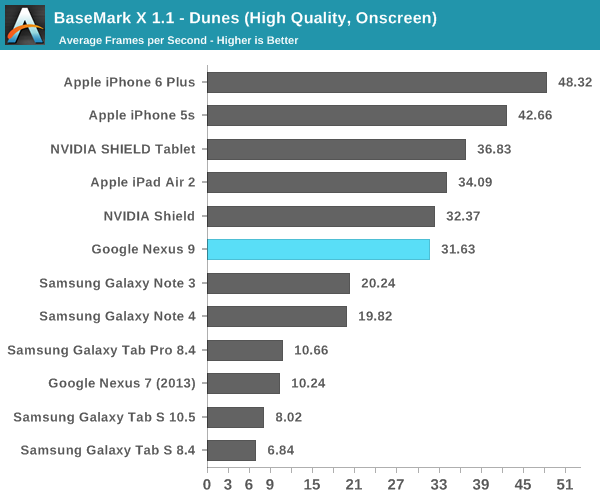

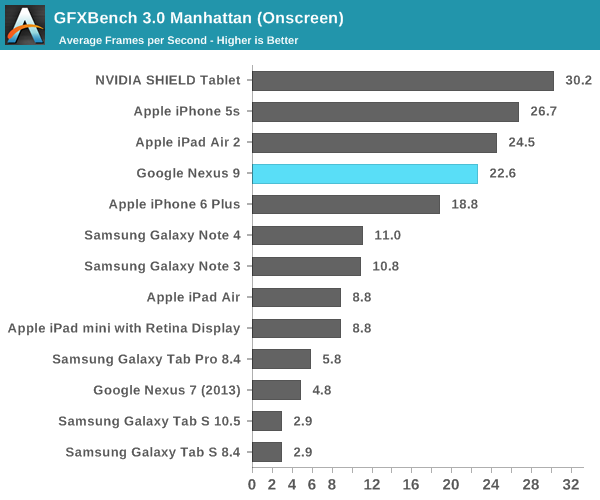
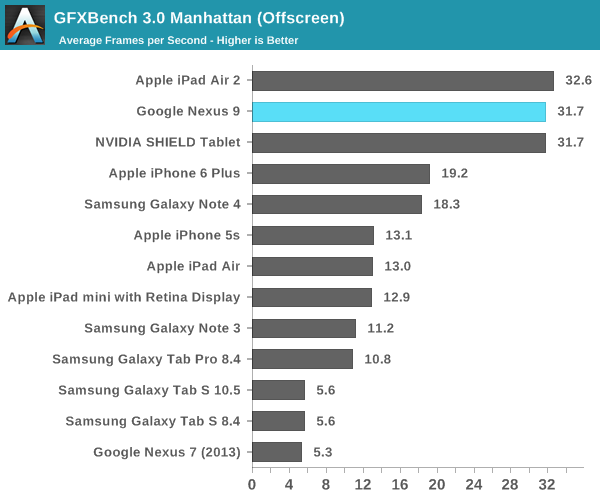
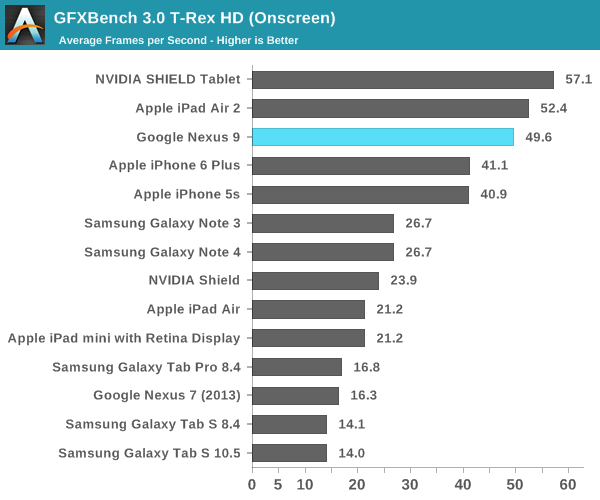
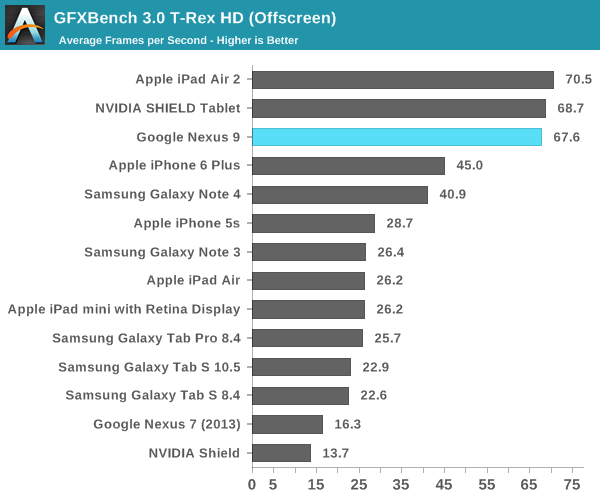
As one can see, the Nexus 9 is effectively equivalent to the SHIELD Tablet in GPU performance. The one anomaly here is 3DMark, which seems to be mostly due to differences in CPU. It's likely that this isn't representative of performance though, as 3DMark's physics test seems to perform better on CPU configurations that rely on larger numbers of cores and higher clock speeds. In the purer GPU tests like Basemark X and GFXBench performance across the board is effectively identical to the Cortex A15 variant of the Tegra K1.
Initial Conclusions
For the most part, the Nexus 9 shows some level of promise as a tablet. While Denver in NVIDIA’s Tegra K1 is a bit bimodal in performance, with sufficient optimization it has immense promise from a sheer performance aspect. While the SoC alone makes the Nexus 9 a fascinating device to look at, the rest of the package has a great deal of potential. The minimalistic design of the device, combined with good material design and stereo front-facing speakers really shows the high-end aspirations of this tablet. While we haven't received anything in the way of accessories, the keyboard folio case seems to be a way of pushing the tablet formfactor in a new direction. This is especially evident when seeing the focus on previous Nexus tablets which seemed to assume touch-only input.
While only a first look, there’s definitely a lot to be impressed by here. However, it will take a full review to really determine whether the Nexus 9 can compete with the iPad Air 2 as a tablet is more than just a function of battery life and SoC performance. In addition, it's hard to draw any real conclusions about this tablet quite yet as the software we received in no way represents a shipping build. Even if inactive, loggers and debug tools generally reduce performance, and it's likely that a great deal of optimization has occurred in the two months since this software build was completed. Once again, we haven't been able to get a newer build, but the full review should be done with shipping firmware.










146 Comments
View All Comments
Ppietra - Monday, November 3, 2014 - link
Since the screen area difference is significantly larger than the battery size difference and both tablets give the same battery life, one can hypothesize that the A8X is more energy efficient than the Tegra k1.kron123456789 - Monday, November 3, 2014 - link
It's no surprise since A8X is 20nm and Tegra K1 is 28nm.chizow - Tuesday, November 4, 2014 - link
Again, can't make any such assumptions based on screen size alone, given early reviews show the Nexus 9 screen is brighter. Apple could've certainly put in a bigger battery or at the very least left the same size as the iPad Air 1, but I guess they wanted to trim weight and cut costs above all else.ams23 - Monday, November 3, 2014 - link
Nexus 9 has higher single-threaded CPU performance than iPad air 2 in Geekbench 3, and has higher performance in Kraken too (and possibly some other tests such as Octane). It depends on the workload and where the CPU can take advantage of dynamic code optimization.testbug00 - Tuesday, November 4, 2014 - link
based on some broken down geekbench single core, the Nvidia chip has about the same IPC in integer (~2800/2.2 Divided by ~1800/1.4 == ~99%) but, it has a huge deficit in FP (~1200/2.2 divided by ~1700/1.4) of only about 45%.Numbers ran in 32 bit for K1 as the 64b Android version that supports the K1 appears to not be functioning as it should. NVidia's numbers should improve a bit, probably to 100-115% of Int and 50-65% of Floating Point.
(The output is Tegra K1 Denver core having 99% Integer and 45% based on multiple-core scores PER CORE of Apple's tri-core A8 chip (~5200/2300 used for Tegra, ~5100/4900 used for tri-core A8)
Ratman6161 - Monday, November 3, 2014 - link
Also don't forget it's Android 5 so besides being an early build of the tablet, the OS may not be final either.Leosch - Tuesday, November 4, 2014 - link
I am pretty sure that the author is referencing the build of the software whenever he reminds us that this is not a final build. The hardware probebly is final, but the software is still on a testing build. Each compilation of a software packet givesLeosch - Tuesday, November 4, 2014 - link
... Sorry hit submit by accident. So I was saying:Each compilation gives you a build which is usually given a build number. In Android you can check your exact build number in the about phone menu in the last menu entry. I bet you can di the same in iOS
testbug00 - Tuesday, November 4, 2014 - link
looking at some numbers broken down in other places, the Denver CPU appears to be about the same IPC with integer code (~99.5% in the only numbers I have seen), and, about 69.1% of the IPC in Floating point code.That is per core. Also, I would say that the GPU in the K1 is faster than Apple's as Nvidia's top bin is 951Mhz according to Nvidia. Apple's is likely lower =] (the performance as a given clockspeed should be equal)
chizow - Monday, November 3, 2014 - link
Very impressive performance from Nvidia's Denver K1, their 1st 64-bit effort basically ties Apple's 2nd-gen 64-bit SoC without even the benefit of 20nm. Expecting big things from Erista next year with 20nm and Maxwell GPU.Overall this device I think missed on the lack of expandable storage and low entry level 16GB storage. Personally I think it is priced too close to iPad to do well, but we shall see. If they went with 32GB or even expandable storage I think it would have been a compelling alternative on the higher-end of tablet market.